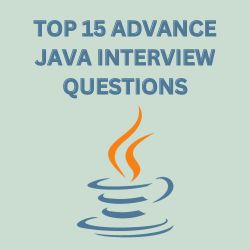Most students don't understand that Advanced Java is not a replacement for Java but rather an extension of it. Advance Java provides an extra set of features and libraries to give developers more power and flexibility. It is used to develop wide range of applications. Using core Java, we can only develop standalone applications, but using Advanced Java, we can develop desktop applications, web applications, mobile applications, and more.
Let's explore some frequently asked advanced Java interview questions and their answers...
Advanced Java Interview Questions:
1. What is servlet?
A servlet is a small Java program that runs within a Web server. Servlets respond to requests from Web clients, usually across HTTP, the HyperText Transfer Protocol.
2. What is JSP?
JavaServer Pages (JSP) technology provides a simplified, fast way to create dynamic web pages. JSP pages are text documents that combine HTML or XHTML code with snippets of Java code.
3. What's the difference between GET and POST?
The primary difference between the two HTTP methods is that GET carries the request parameters in the URL while POST passes them in the message body.
4. What is a session?
A session is a single interaction between a user and a web site. A session typically starts when a user navigates to a web site and ends when they leave the site or close their browser. During a session, the web server tracks information about the user's interactions with the site using what's called a session ID. This ID can be stored in either a cookie on the user's computer or as part of the URL itself (known as a URL parameter).
5. What is cookies?
Cookies are small pieces of data that a server sends to a user's web browser when user visits a website. These cookies contain information like user preferences, login details, or even just a session identifier. So the next time the user visits the same website, the browser sends the stored cookies back to the server. This helps the server recognize the user and retrieve their previous session or preferences. It's like a secret handshake between the browser and the server.
6. What is the difference between Servlet and JSP?
Servlets are Java programs that run on the server and handle HTTP requests and responses. JSP, on the other hand, is a technology for embedding Java code in HTML pages. Servlets are primarily Java-centric, while JSP allows the integration of Java code into HTML for dynamic web page generation.
7. Explain the lifecycle of a Servlet.
The Servlet lifecycle includes initialization, service, and destruction phases. The `init()` method is called once during initialization, the `service()` method handles requests, and the `destroy()` method is called when the Servlet is being removed from service.
8. What is the purpose of the `web.xml` file in a Servlet application?
The `web.xml` file is the deployment descriptor for a Servlet application. It contains configuration information such as Servlet mappings, initialization parameters, and error pages.
9. Differentiate between forward and sendRedirect in Servlets.
Forward is done on the server-side, and the request is internally forwarded to another resource. In sendRedirect, the response sends a redirect header to the browser, and the browser makes a new request to the redirected resource.
10. Explain the MVC (Model-View-Controller) architecture and how it is implemented in Servlets.
MVC is a design pattern separating an application into three interconnected components: Model (data), View (presentation), and Controller (business logic). In Servlets, the controller manages the flow, the model represents data, and the view handles the presentation.
11. What is a JSP tag library?
A JSP tag library consists of a set of custom tags that can be used in JSP pages. Tag libraries abstract complex behavior into simple tags, enhancing the modularity and readability of JSP pages.
12. How does session tracking work in Servlets?
Session tracking in Servlets is achieved using mechanisms like cookies, URL rewriting, and HttpSession. HttpSession allows the server to associate a set of key-value pairs with each client, maintaining state across multiple requests.
13. Explain the purpose of the init() and destroy() methods in a JSP page.
The init() method is called when a JSP page is first loaded into memory, and the destroy() method is called when the JSP page is being unloaded. They can be used for initializing and releasing resources, respectively.
14. What is the difference between include directive (<%@ include %>) and action (<jsp:include>) in JSP?
The include directive includes the content of another file during the translation phase, while the JSP include action includes the content during the execution phase. The include directive is processed at the time of JSP page translation, and the included file becomes part of the JSP page.
15. How does exception handling work in JSP?
In JSP, exceptions can be handled using the errorPage attribute in the page directive. When an exception occurs, the control is transferred to the specified error page, where the error information can be displayed.
These are the most commonly asked top 15 interview questions and answers. I hope it will help you in your Java interview. All the best for your Java interviews!
Happy coding.. :)


No comments:
Post a Comment
If you have any doubts, please discuss here...👇